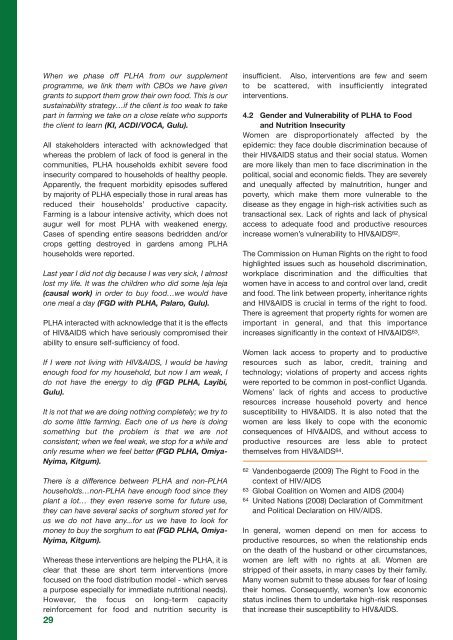Uganda Report 2012 FINAL PO:Layout 1 - ACORD
Uganda Report 2012 FINAL PO:Layout 1 - ACORD
Uganda Report 2012 FINAL PO:Layout 1 - ACORD
You also want an ePaper? Increase the reach of your titles
YUMPU automatically turns print PDFs into web optimized ePapers that Google loves.
When we phase off PLHA from our supplement<br />
programme, we link them with CBOs we have given<br />
grants to support them grow their own food. This is our<br />
sustainability strategy…if the client is too weak to take<br />
part in farming we take on a close relate who supports<br />
the client to learn (KI, ACDI/VOCA, Gulu).<br />
All stakeholders interacted with acknowledged that<br />
whereas the problem of lack of food is general in the<br />
communities, PLHA households exhibit severe food<br />
insecurity compared to households of healthy people.<br />
Apparently, the frequent morbidity episodes suffered<br />
by majority of PLHA especially those in rural areas has<br />
reduced their households’ productive capacity.<br />
Farming is a labour intensive activity, which does not<br />
augur well for most PLHA with weakened energy.<br />
Cases of spending entire seasons bedridden and/or<br />
crops getting destroyed in gardens among PLHA<br />
households were reported.<br />
Last year I did not dig because I was very sick, I almost<br />
lost my life. It was the children who did some leja leja<br />
(causal work) in order to buy food…we would have<br />
one meal a day (FGD with PLHA, Palaro, Gulu).<br />
PLHA interacted with acknowledge that it is the effects<br />
of HIV&AIDS which have seriously compromised their<br />
ability to ensure self-sufficiency of food.<br />
If I were not living with HIV&AIDS, I would be having<br />
enough food for my household, but now I am weak, I<br />
do not have the energy to dig (FGD PLHA, Layibi,<br />
Gulu).<br />
It is not that we are doing nothing completely; we try to<br />
do some little farming. Each one of us here is doing<br />
something but the problem is that we are not<br />
consistent; when we feel weak, we stop for a while and<br />
only resume when we feel better (FGD PLHA, Omiya-<br />
Nyima, Kitgum).<br />
There is a difference between PLHA and non-PLHA<br />
households…non-PLHA have enough food since they<br />
plant a lot… they even reserve some for future use,<br />
they can have several sacks of sorghum stored yet for<br />
us we do not have any...for us we have to look for<br />
money to buy the sorghum to eat (FGD PLHA, Omiya-<br />
Nyima, Kitgum).<br />
Whereas these interventions are helping the PLHA, it is<br />
clear that these are short term interventions (more<br />
focused on the food distribution model - which serves<br />
a purpose especially for immediate nutritional needs).<br />
However, the focus on long-term capacity<br />
reinforcement for food and nutrition security is<br />
29<br />
insufficient. Also, interventions are few and seem<br />
to be scattered, with insufficiently integrated<br />
interventions.<br />
4.2 Gender and Vulnerability of PLHA to Food<br />
and Nutrition Insecurity<br />
Women are disproportionately affected by the<br />
epidemic: they face double discrimination because of<br />
their HIV&AIDS status and their social status. Women<br />
are more likely than men to face discrimination in the<br />
political, social and economic fields. They are severely<br />
and unequally affected by malnutrition, hunger and<br />
poverty, which make them more vulnerable to the<br />
disease as they engage in high-risk activities such as<br />
transactional sex. Lack of rights and lack of physical<br />
access to adequate food and productive resources<br />
increase women’s vulnerability to HIV&AIDS 62 .<br />
The Commission on Human Rights on the right to food<br />
highlighted issues such as household discrimination,<br />
workplace discrimination and the difficulties that<br />
women have in access to and control over land, credit<br />
and food. The link between property, inheritance rights<br />
and HIV&AIDS is crucial in terms of the right to food.<br />
There is agreement that property rights for women are<br />
important in general, and that this importance<br />
increases significantly in the context of HIV&AIDS 63 .<br />
Women lack access to property and to productive<br />
resources such as labor, credit, training and<br />
technology; violations of property and access rights<br />
were reported to be common in post-conflict <strong>Uganda</strong>.<br />
Womens’ lack of rights and access to productive<br />
resources increase household poverty and hence<br />
susceptibility to HIV&AIDS. It is also noted that the<br />
women are less likely to cope with the economic<br />
consequences of HIV&AIDS, and without access to<br />
productive resources are less able to protect<br />
themselves from HIV&AIDS 64 .<br />
62 Vandenbogaerde (2009) The Right to Food in the<br />
context of HIV/AIDS<br />
63 Global Coalition on Women and AIDS (2004)<br />
64 United Nations (2008) Declaration of Commitment<br />
and Political Declaration on HIV/AIDS.<br />
In general, women depend on men for access to<br />
productive resources, so when the relationship ends<br />
on the death of the husband or other circumstances,<br />
women are left with no rights at all. Women are<br />
stripped of their assets, in many cases by their family.<br />
Many women submit to these abuses for fear of losing<br />
their homes. Consequently, women’s low economic<br />
status inclines them to undertake high-risk responses<br />
that increase their susceptibility to HIV&AIDS.





